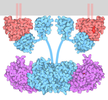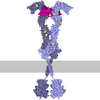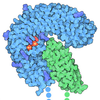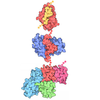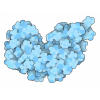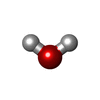+ Open data
Open data
- Basic information
Basic information
| Entry | Database: PDB / ID: 1www | ||||||
|---|---|---|---|---|---|---|---|
| Title | NGF IN COMPLEX WITH DOMAIN 5 OF THE TRKA RECEPTOR | ||||||
 Components Components |
| ||||||
 Keywords Keywords | NERVE GROWTH FACTOR/TRKA COMPLEX / COMPLEX / TRKA RECEPTOR / NERVE GROWTH FACTOR / CYSTEINE KNOT / IMMUNOGLOBULIN LIKE DOMAIN / NERVE GROWTH FACTOR-TRKA COMPLEX COMPLEX | ||||||
| Function / homology |  Function and homology information Function and homology informationNFG and proNGF binds to p75NTR / Ceramide signalling / nerve growth factor receptor binding / NGF processing / neurotrophin p75 receptor binding / behavioral response to formalin induced pain / olfactory nerve development / positive regulation of neuron maturation / TRKA activation by NGF / PLC-gamma1 signalling ...NFG and proNGF binds to p75NTR / Ceramide signalling / nerve growth factor receptor binding / NGF processing / neurotrophin p75 receptor binding / behavioral response to formalin induced pain / olfactory nerve development / positive regulation of neuron maturation / TRKA activation by NGF / PLC-gamma1 signalling / Signalling to STAT3 / programmed cell death involved in cell development / response to hydrostatic pressure / neurotrophin receptor activity / mechanoreceptor differentiation / nerve growth factor receptor activity / neurotrophin binding / metalloendopeptidase inhibitor activity / p75NTR negatively regulates cell cycle via SC1 / GPI-linked ephrin receptor activity / axonogenesis involved in innervation / nerve growth factor signaling pathway / nerve growth factor binding / Sertoli cell development / nerve development / Retrograde neurotrophin signalling / Axonal growth stimulation / NADE modulates death signalling / regulation of neurotransmitter secretion / positive regulation of collateral sprouting / sympathetic nervous system development / NGF-independant TRKA activation / peripheral nervous system development / Signalling to p38 via RIT and RIN / transmembrane receptor protein tyrosine kinase activator activity / ARMS-mediated activation / regulation of release of sequestered calcium ion into cytosol / axon extension / positive regulation of programmed cell death / positive regulation of Ras protein signal transduction / positive regulation of synapse assembly / PI3K/AKT activation / peptidyl-tyrosine autophosphorylation / Frs2-mediated activation / NRAGE signals death through JNK / neurotrophin TRK receptor signaling pathway / detection of temperature stimulus involved in sensory perception of pain / response to electrical stimulus / extrinsic apoptotic signaling pathway via death domain receptors / positive regulation of GTPase activity / Signalling to RAS / detection of mechanical stimulus involved in sensory perception of pain / neuron development / positive regulation of synaptic transmission, glutamatergic / response to axon injury / positive regulation of axon extension / neuron projection morphogenesis / extrinsic apoptotic signaling pathway in absence of ligand / transmembrane receptor protein tyrosine kinase activity / sensory perception of pain / positive regulation of neuron differentiation / p75NTR recruits signalling complexes / axon guidance / NF-kB is activated and signals survival / cell surface receptor protein tyrosine kinase signaling pathway / NRIF signals cell death from the nucleus / peptidyl-tyrosine phosphorylation / B cell differentiation / positive regulation of protein ubiquitination / endosome lumen / growth factor activity / response to nutrient levels / : / circadian rhythm / positive regulation of neuron projection development / receptor protein-tyrosine kinase / cellular response to nerve growth factor stimulus / modulation of chemical synaptic transmission / cellular response to nicotine / Golgi lumen / kinase binding / recycling endosome membrane / neuron projection development / positive regulation of angiogenesis / synaptic vesicle / late endosome membrane / late endosome / protein autophosphorylation / protein tyrosine kinase activity / neuron apoptotic process / early endosome membrane / spermatogenesis / negative regulation of neuron apoptotic process / learning or memory / early endosome / positive regulation of ERK1 and ERK2 cascade / protein phosphorylation / positive regulation of phosphatidylinositol 3-kinase/protein kinase B signal transduction / receptor complex / endosome membrane Similarity search - Function | ||||||
| Biological species |  Homo sapiens (human) Homo sapiens (human) | ||||||
| Method |  X-RAY DIFFRACTION / X-RAY DIFFRACTION /  SYNCHROTRON / SYNCHROTRON /  MOLECULAR REPLACEMENT / Resolution: 2.2 Å MOLECULAR REPLACEMENT / Resolution: 2.2 Å | ||||||
 Authors Authors | Wiesmann, C. / Ultsch, M.H. / De Vos, A.M. | ||||||
 Citation Citation |  Journal: Nature / Year: 1999 Journal: Nature / Year: 1999Title: Crystal structure of nerve growth factor in complex with the ligand-binding domain of the TrkA receptor. Authors: Wiesmann, C. / Ultsch, M.H. / Bass, S.H. / de Vos, A.M. | ||||||
| History |
|
- Structure visualization
Structure visualization
| Structure viewer | Molecule:  Molmil Molmil Jmol/JSmol Jmol/JSmol |
|---|
- Downloads & links
Downloads & links
- Download
Download
| PDBx/mmCIF format |  1www.cif.gz 1www.cif.gz | 98.8 KB | Display |  PDBx/mmCIF format PDBx/mmCIF format |
|---|---|---|---|---|
| PDB format |  pdb1www.ent.gz pdb1www.ent.gz | 75.7 KB | Display |  PDB format PDB format |
| PDBx/mmJSON format |  1www.json.gz 1www.json.gz | Tree view |  PDBx/mmJSON format PDBx/mmJSON format | |
| Others |  Other downloads Other downloads |
-Validation report
| Summary document |  1www_validation.pdf.gz 1www_validation.pdf.gz | 388.5 KB | Display |  wwPDB validaton report wwPDB validaton report |
|---|---|---|---|---|
| Full document |  1www_full_validation.pdf.gz 1www_full_validation.pdf.gz | 406.9 KB | Display | |
| Data in XML |  1www_validation.xml.gz 1www_validation.xml.gz | 11.2 KB | Display | |
| Data in CIF |  1www_validation.cif.gz 1www_validation.cif.gz | 18.3 KB | Display | |
| Arichive directory |  https://data.pdbj.org/pub/pdb/validation_reports/ww/1www https://data.pdbj.org/pub/pdb/validation_reports/ww/1www ftp://data.pdbj.org/pub/pdb/validation_reports/ww/1www ftp://data.pdbj.org/pub/pdb/validation_reports/ww/1www | HTTPS FTP |
-Related structure data
| Related structure data |  1betS S: Starting model for refinement |
|---|---|
| Similar structure data |
- Links
Links
- Assembly
Assembly
| Deposited unit | 
| ||||||||||||
|---|---|---|---|---|---|---|---|---|---|---|---|---|---|
| 1 |
| ||||||||||||
| Unit cell |
| ||||||||||||
| Noncrystallographic symmetry (NCS) | NCS oper:
|
- Components
Components
| #1: Protein | Mass: 13515.410 Da / Num. of mol.: 2 Source method: isolated from a genetically manipulated source Source: (gene. exp.)  Homo sapiens (human) / Production host: Homo sapiens (human) / Production host:  #2: Protein | Mass: 11107.459 Da / Num. of mol.: 2 / Fragment: DOMAIN 5 Source method: isolated from a genetically manipulated source Source: (gene. exp.)  Homo sapiens (human) / Production host: Homo sapiens (human) / Production host:  #3: Water | ChemComp-HOH / | Has protein modification | Y | |
|---|
-Experimental details
-Experiment
| Experiment | Method:  X-RAY DIFFRACTION / Number of used crystals: 1 X-RAY DIFFRACTION / Number of used crystals: 1 |
|---|
- Sample preparation
Sample preparation
| Crystal | Density Matthews: 2.34 Å3/Da / Density % sol: 47.38 % Description: DATA WERE COLLECTED AT THE ADVANCED LIGHT SOURCE, BERKELEY | ||||||||||||||||||||||||||||||||||||
|---|---|---|---|---|---|---|---|---|---|---|---|---|---|---|---|---|---|---|---|---|---|---|---|---|---|---|---|---|---|---|---|---|---|---|---|---|---|
| Crystal grow | pH: 5 / Details: pH 5.0 | ||||||||||||||||||||||||||||||||||||
| Crystal grow | *PLUS pH: 8.5 / Method: vapor diffusion, hanging drop | ||||||||||||||||||||||||||||||||||||
| Components of the solutions | *PLUS
|
-Data collection
| Diffraction | Mean temperature: 160 K |
|---|---|
| Diffraction source | Source:  SYNCHROTRON / Site: SYNCHROTRON / Site:  ALS ALS  / Beamline: 5.0.2 / Wavelength: 1 / Beamline: 5.0.2 / Wavelength: 1 |
| Radiation | Protocol: SINGLE WAVELENGTH / Monochromatic (M) / Laue (L): M / Scattering type: x-ray |
| Radiation wavelength | Wavelength: 1 Å / Relative weight: 1 |
| Reflection | Resolution: 2.2→20 Å / Num. obs: 23361 / % possible obs: 99.8 % / Redundancy: 4 % / Rsym value: 0.071 / Net I/σ(I): 7.7 |
| Reflection shell | Resolution: 2.2→2.28 Å / Redundancy: 3.5 % / Rsym value: 0.355 / % possible all: 98.7 |
| Reflection | *PLUS Rmerge(I) obs: 0.071 |
| Reflection shell | *PLUS Rmerge(I) obs: 0.355 |
- Processing
Processing
| Software |
| ||||||||||||||||||||||||||||||||||||||||||||||||||||||||||||
|---|---|---|---|---|---|---|---|---|---|---|---|---|---|---|---|---|---|---|---|---|---|---|---|---|---|---|---|---|---|---|---|---|---|---|---|---|---|---|---|---|---|---|---|---|---|---|---|---|---|---|---|---|---|---|---|---|---|---|---|---|---|
| Refinement | Method to determine structure:  MOLECULAR REPLACEMENT MOLECULAR REPLACEMENTStarting model: 1BET Resolution: 2.2→20 Å / Data cutoff high absF: 10000000 / Data cutoff low absF: 0.001 / Cross valid method: THROUGOUT / σ(F): 0.2
| ||||||||||||||||||||||||||||||||||||||||||||||||||||||||||||
| Refinement step | Cycle: LAST / Resolution: 2.2→20 Å
| ||||||||||||||||||||||||||||||||||||||||||||||||||||||||||||
| Refine LS restraints |
| ||||||||||||||||||||||||||||||||||||||||||||||||||||||||||||
| LS refinement shell | Resolution: 2.2→2.3 Å / Total num. of bins used: 8
| ||||||||||||||||||||||||||||||||||||||||||||||||||||||||||||
| Software | *PLUS Name:  X-PLOR / Version: 3.851 / Classification: refinement X-PLOR / Version: 3.851 / Classification: refinement | ||||||||||||||||||||||||||||||||||||||||||||||||||||||||||||
| Refinement | *PLUS Highest resolution: 2.2 Å / Lowest resolution: 20 Å / % reflection Rfree: 10 % / Rfactor obs: 0.189 | ||||||||||||||||||||||||||||||||||||||||||||||||||||||||||||
| Solvent computation | *PLUS | ||||||||||||||||||||||||||||||||||||||||||||||||||||||||||||
| Displacement parameters | *PLUS | ||||||||||||||||||||||||||||||||||||||||||||||||||||||||||||
| Refine LS restraints | *PLUS Type: x_angle_deg / Dev ideal: 1.91 | ||||||||||||||||||||||||||||||||||||||||||||||||||||||||||||
| LS refinement shell | *PLUS Highest resolution: 2.2 Å / Lowest resolution: 2.3 Å / % reflection Rfree: 9.1 % / Rfactor Rwork: 0.283 |
 Movie
Movie Controller
Controller






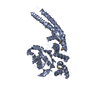

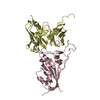


 PDBj
PDBj
